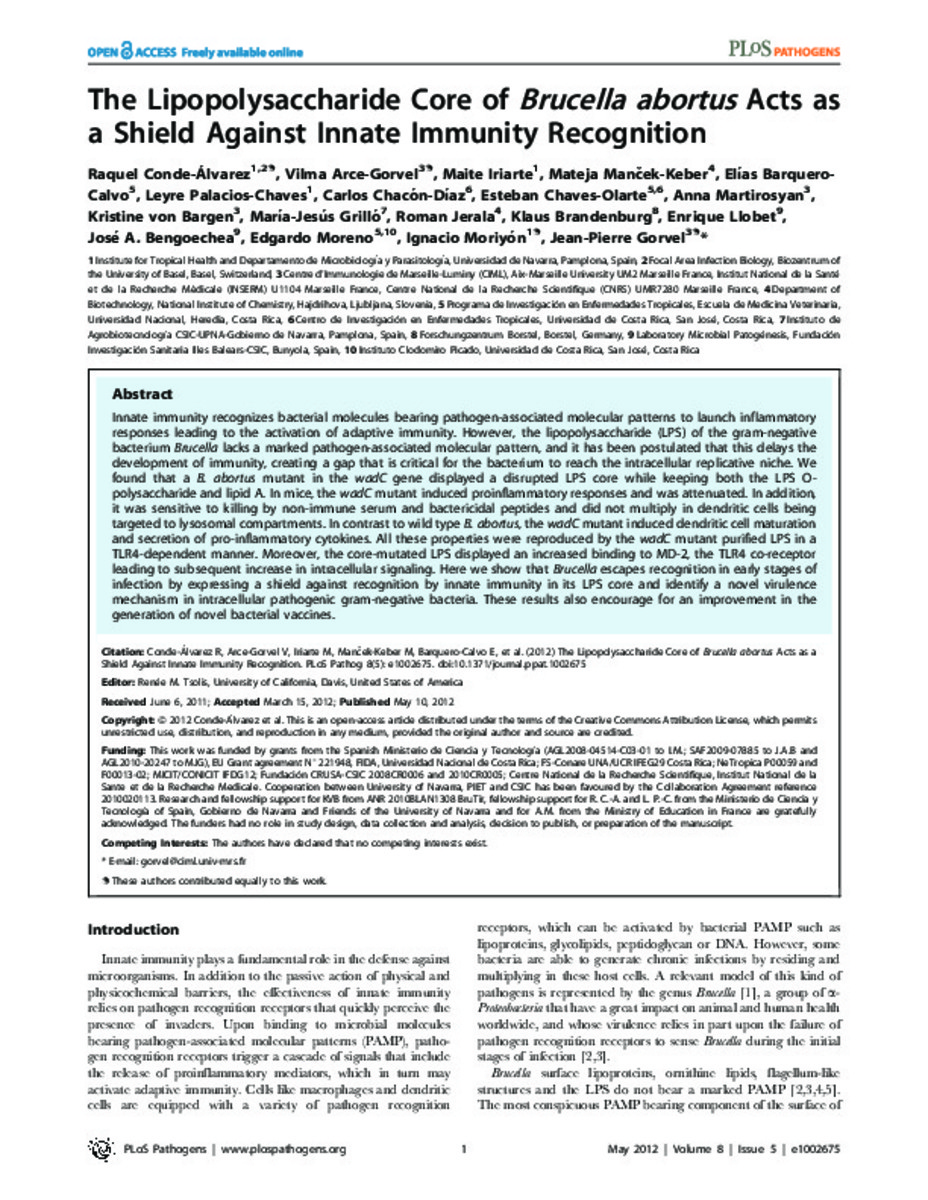Full metadata record
| DC Field | Value | Language |
|---|---|---|
| dc.creator | Raquel | - |
| dc.creator | Arce-Gorvel, V. (Vilma) | - |
| dc.creator | Iriarte, M. (Maite) | - |
| dc.creator | Mancek-Keber, M. (Mateja) | - |
| dc.creator | Barquero-Calvo, E. (Elías) | - |
| dc.creator | Palacios-Chaves, L. (Leyre) | - |
| dc.creator | Chacon-Diaz, C. (Carlos) | - |
| dc.creator | Chaves-Olarte, E. (Esteban) | - |
| dc.creator | Martirosyan, A. (Anna) | - |
| dc.creator | Bargen, K. (Kristine) von | - |
| dc.creator | Grillo, M.J. (María Jesús) | - |
| dc.creator | Jerala, R. (Roman) | - |
| dc.creator | Brandenburg, K. (Klaus) | - |
| dc.creator | Llobet, E. (Enrique) | - |
| dc.creator | Bengoechea, J.A. (José A.) | - |
| dc.creator | Moreno, E. (Edgardo) | - |
| dc.creator | Moriyon, I. (Ignacio) | - |
| dc.creator | Gorvel, J.P. (Jean Pierre) | - |
| dc.date.accessioned | 2013-06-14T07:41:13Z | - |
| dc.date.available | 2013-06-14T07:41:13Z | - |
| dc.date.issued | 2012 | - |
| dc.identifier.citation | Conde-Alvarez R, Arce-Gorvel V, Iriarte M, Mancek-Keber M, Barquero-Calvo E, Palacios-Chaves L, et al. The lipopolysaccharide core of Brucella abortus acts as a shield against innate immunity recognition. PLoS Pathog 2012;8(5):e1002675. | es_ES |
| dc.identifier.issn | 1553-7374 | - |
| dc.identifier.uri | https://hdl.handle.net/10171/29362 | - |
| dc.description.abstract | Innate immunity recognizes bacterial molecules bearing pathogen-associated molecular patterns to launch inflammatory responses leading to the activation of adaptive immunity. However, the lipopolysaccharide (LPS) of the gram-negative bacterium Brucella lacks a marked pathogen-associated molecular pattern, and it has been postulated that this delays the development of immunity, creating a gap that is critical for the bacterium to reach the intracellular replicative niche. We found that a B. abortus mutant in the wadC gene displayed a disrupted LPS core while keeping both the LPS O-polysaccharide and lipid A. In mice, the wadC mutant induced proinflammatory responses and was attenuated. In addition, it was sensitive to killing by non-immune serum and bactericidal peptides and did not multiply in dendritic cells being targeted to lysosomal compartments. In contrast to wild type B. abortus, the wadC mutant induced dendritic cell maturation and secretion of pro-inflammatory cytokines. All these properties were reproduced by the wadC mutant purified LPS in a TLR4-dependent manner. Moreover, the core-mutated LPS displayed an increased binding to MD-2, the TLR4 co-receptor leading to subsequent increase in intracellular signaling. Here we show that Brucella escapes recognition in early stages of infection by expressing a shield against recognition by innate immunity in its LPS core and identify a novel virulence mechanism in intracellular pathogenic gram-negative bacteria. These results also encourage for an improvement in the generation of novel bacterial vaccines. | es_ES |
| dc.language.iso | eng | es_ES |
| dc.publisher | Public Library of Science | es_ES |
| dc.relation | info:eu-repo/grantAgreement/EC/FP7/221948 | - |
| dc.rights | info:eu-repo/semantics/openAccess | es_ES |
| dc.subject | Brucella abortus | es_ES |
| dc.subject | Immune evasion | es_ES |
| dc.subject | Immunity | es_ES |
| dc.subject | Lipopolysaccharides | es_ES |
| dc.subject | Lysosomes | es_ES |
| dc.title | The lipopolysaccharide core of Brucella abortus acts as a shield against innate immunity recognition | es_ES |
| dc.type | info:eu-repo/semantics/article | es_ES |
| dc.type.driver | info:eu-repo/semantics/article | es_ES |
| dc.identifier.doi | http://dx.doi.org/10.1371/journal.ppat.1002675 | es_ES |
Files in This Item:
Statistics and impact
Items in Dadun are protected by copyright, with all rights reserved, unless otherwise indicated.






